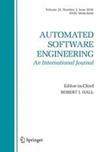水下电缆故障检测ROS发展概况
IF 2
2区 计算机科学
Q3 COMPUTER SCIENCE, SOFTWARE ENGINEERING
引用次数: 0
摘要
本文介绍了开源机器人操作系统ROS。就进程管理和调度而言,ROS不是一个操作系统。这项研究解释了机器人操作系统(ROS)如何在没有人工干预的情况下远程和谨慎地控制物品(如车辆)。相反,它在主机操作系统之上为异构计算集群提供了一个结构化的通信层。本文档快速解释了ROS如何适应当前的机器人软件架构,以及我们如何将其用于auv(自动水下航行器)。将整个世界连接到互联网的媒介之一是光缆,它通常安装在地下或水下。因此,彻底检查它们是一项挑战,因为这样做的成本更高。为了解决这个问题,我们提出了一个解决方案,包括开发一个机器人操作系统,以帮助检查水下/地下电缆。为了将其付诸实践,我们一直在使用VMWare Workstation虚拟安装Ubuntu OS,我们将在其中安装ROS软件包,ROS- gazebo工具箱是主要工具之一。我们正在用标准输入测试实现的软件。我们使用光辐射作为评估光缆状况的主要因素。本文章由计算机程序翻译,如有差异,请以英文原文为准。
Survey Paper on Development of ROS for Fault Detection of Underwater Cables
: An introduction to ROS, an open source robot operating system, is given in this paper. In terms of process management and scheduling, ROS is not an operating system. This study explains how Robotic Operating System (ROS) can be used to control items (such as vehicles) remotely and cautiously without human intervention at the location. Instead, it gives heterogeneous computing clusters a structured communication layer on top of the host operating system. This document gives a quick explanation of how ROS fits into the current robot software architecture and how we may utilize it for AUVs (Automated under water vehicle). One of the media that connects the entire world to the internet is optical cable, which is typically installed underground or under water. As a result, it is challenging to inspect them thoroughly because it costs more to do so. To address this issue, we are presenting a solution that involves developing a robotic operating system that would assist in checking the underwater/underground cables. To put this into practice, we have been utilizing VMWare Workstation to virtually install Ubuntu OS, where we will be installing ROS packages, with the ROS-Gazebo toolbox serving as one of the primary tools. We are testing the implemented software with the standard inputs. We are using light radiation as the primary factor to assess the condition of the optical cable.
求助全文
通过发布文献求助,成功后即可免费获取论文全文。
去求助
来源期刊

Automated Software Engineering
工程技术-计算机:软件工程
CiteScore
4.80
自引率
11.80%
发文量
51
审稿时长
>12 weeks
期刊介绍:
This journal details research, tutorial papers, survey and accounts of significant industrial experience in the foundations, techniques, tools and applications of automated software engineering technology. This includes the study of techniques for constructing, understanding, adapting, and modeling software artifacts and processes.
Coverage in Automated Software Engineering examines both automatic systems and collaborative systems as well as computational models of human software engineering activities. In addition, it presents knowledge representations and artificial intelligence techniques applicable to automated software engineering, and formal techniques that support or provide theoretical foundations. The journal also includes reviews of books, software, conferences and workshops.
 求助内容:
求助内容: 应助结果提醒方式:
应助结果提醒方式:


